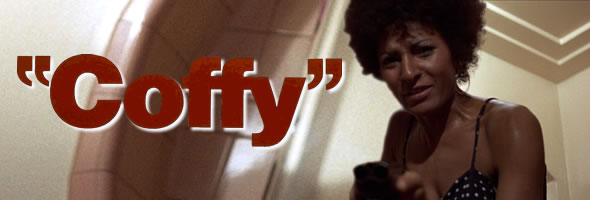
Color, 1973, 90m.
Directed by Jack Hill
Starring Pam Grier, Booker Bradshaw, Robert DoQui, William Elliott, Allan Arbus, Sid Haig
Arrow (Blu-ray) (UK RB HD) / WS (1.85:1) (16:9), MGM (DVD) (US R1 NTSC) / WS (1.66:1)

Color, 1973, 90m.
Directed by Jack Hill
Starring Pam Grier, Booker Bradshaw, Robert DoQui, William Elliott, Allan Arbus, Sid Haig
Arrow (Blu-ray) (UK RB HD) / WS (1.85:1) (16:9), MGM (DVD) (US R1 NTSC) / WS (1.66:1)
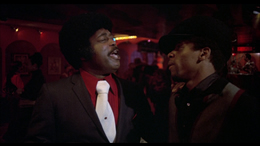 Following their successful pair of women's prison yarns, The Big Doll House and The Big Bird Cage, director Jack Hill and rising star
Following their successful pair of women's prison yarns, The Big Doll House and The Big Bird Cage, director Jack Hill and rising star 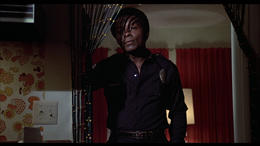 Pam Grier moved from Roger Corman to Samuel Arkoff's American International Pictures for two of the most popular and enduring black action films ever made, Coffy and Foxy Brown. These stylized comic books for the silver screen presented strong heroines, fast and brutal action, snappy and often uproarious dialogue, and an uncanny knack for rousing the audience to cheers at least once every five minutes. Though blaxploitation was mostly ignored during the '80s, its resurgence thanks to the support of fans like Quentin Tarantino and the easy accessibility of home video have given these classics far more exposure than their inner city and drive-in runs back in the '70s.
Pam Grier moved from Roger Corman to Samuel Arkoff's American International Pictures for two of the most popular and enduring black action films ever made, Coffy and Foxy Brown. These stylized comic books for the silver screen presented strong heroines, fast and brutal action, snappy and often uproarious dialogue, and an uncanny knack for rousing the audience to cheers at least once every five minutes. Though blaxploitation was mostly ignored during the '80s, its resurgence thanks to the support of fans like Quentin Tarantino and the easy accessibility of home video have given these classics far more exposure than their inner city and drive-in runs back in the '70s.
In Coffy, Grier portrays the title character, a nurse who decides to tear down the drug network that left her little sister an emotionally devastated junkie. The film opens with a rousing set piece in which Coffy, posing as a junkie hooker, deals out justice via shotgun and syringe, and then returns home to the loving arms of her straight and narrow boyfriend, Howard (Bradshaw). Coffy's detective work leads her to the outrageous drug dealing pimp, King George (DoQui), who comes complete with his own theme song and a stable of sexy call girls. Coffy poses as a Jamaican whore (yes, really) to get closer to King George and discover his insidious connections. After a series of cat fights, double crosses, and baddie bashing, Coffy eventually uncovers the horrible, 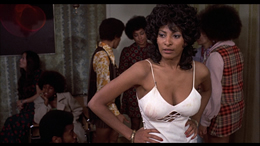 tragic truth behind drug dealing circuit.
tragic truth behind drug dealing circuit.
In this film, everything simply works perfectly. Grier is at her best supplying plenty of high kicking, gun blasting, and skin baring, while Hill clearly put all of himself into the screenplay and direction, both of which are more slick and insightful than the average viewer would ever expect from an exploitation film. The story moves along at a fast clip and even finds room for a terrific turn by Hill regular Sid Haig as ruthless Russian "Omar," while the always intriguing Alan Arbus (Greaser's Palace) turns up to represent the corrupt white component of the drug trade. Of course, the film wouldn't be complete without that funky, catchy score by R&B artist Roy Ayers... but be warned, the theme song will stick in your head for days.
Coffy was first released on VHS by Orion, whose full frame transfer was completely open matte and looked quite good at the time if compositionally out of whack. A laserdisc edition briefly appeared before passing over into MGM's "Soul Cinema" collection. Contrary to the packaging which cites an aspect ration of 1.85:1, Coffy is actually 1.66:1, which works well enough. The disc also includes the theatrical trailer and a Jack Hill commentary, which ties in nicely with his one on the Foxy Brown DVD as he ties together his relationship with AIP at the time and his rapport with Grier and Haig. 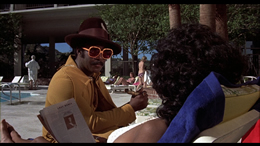
For some reason MGM never bothered to reissue the film in an anamorphic transfer on DVD even for its Pam Grier boxed set, but in 2015, Arrow Films unveiled an extras-packed Blu-ray as essential as their earlier deluxe 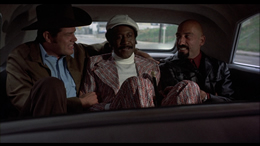 version of Foxy. The impressive HD transfer (seen occasionally on MGM HD airings) looks great, with the 1.85.1 framing looking compositionally sound as well and the closest to how this originally played drive-ins and city theaters. No complaints with the LPCM audio, either, which sounds robust and true to the source.
version of Foxy. The impressive HD transfer (seen occasionally on MGM HD airings) looks great, with the 1.85.1 framing looking compositionally sound as well and the closest to how this originally played drive-ins and city theaters. No complaints with the LPCM audio, either, which sounds robust and true to the source.
The Hill commentary is ported over here along with the trailer, but otherwise it's all new material starting off with a new 19-minute Hill video interview. It overlaps a bit with some of his commentary anecdotes but as usual he's very articulate and remembers a great deal about working on the film, which he feels is the more serious and polished of the two Grier star vehicles. Then the star herself gets a 17-minute interview about how she drew inspiration from the strength of other women in her life, breaking her ankle during the freeway chase, first meeting Hill, and being impressed by her director's command of international film history. The video essay "Blaxploitation!" by Mikel J. Koven offers a 29-minute breakdown of the movement's history and antecedents (including the troublesome early days of blackface and D.W. Griffith), actually spending time on the ins and outs of black-themed cinema before really getting to the topic at hand over 12 minutes in. It's a little more academic than you'd expect from the title but worth a look as a sort of mini-college lit piece, taking a pretty negative stance on many of the key titles like Shaft along the way; if you've ready his giallo study La Dolce Morte or his Blaxploitation Films book, this is a pretty close visual equivalent. Finally the disc rounds out with a gallery of stills and promotional artwork and a liner notes booklet containing an essay by Cullen Gallagher and a Grier career overview by Yvonne D. Sims. The film is also slated for an upcoming American release from Olive Films, which will presumably not overlap in the extras department.
![]()